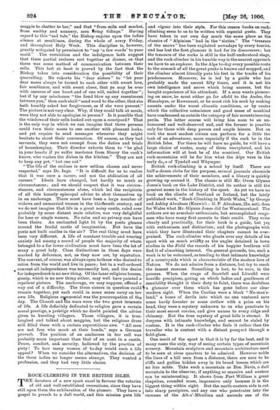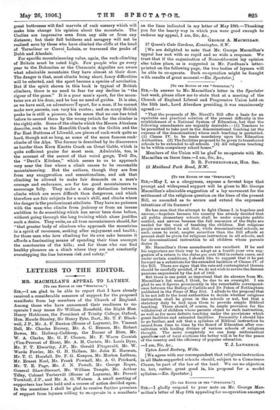ROCK-CLIMBING IN THE BRITISH ISLES.
THE devotees of a new sport excel in fervour the votaries of old and well-established recreations, since they have still upon them the exhilaration of the pioneer. They have a gospel to preach to a dull world, and this mission puts life and vigour into their style. For this reason -books on -rock- climbing seem to us to be written with, especial gusto, They have taken in our own day much the same place as the classics of " Alpinism " had in the "sixties." The "treasure of the snows " has been exploited nowadays by every tourist, and has lost the first glamour it had for its discoverers ; but the treasure of the rocks is still in the half-understood stage, and the rock-climber in his humble way is the nearest approach we have to an explorer. In the Alps to-day every possible route to the summit of all the great peaks is known and mapped, and the climber almost literally puts his feet in the tracks of his predecessors. Moreover, be is led by a guide who has probably made the ascent fifty times, and it is, not his own intelligence and nerve which bring success, but the bought experience of his attendant. If a man wants pioneer- ing on snow, he must either go far afield to the Andes, the Himalayas, or Ruwenzori, or he must risk his neck by making ascents under the worst climatic conditions, or by routes which the collective conscience and good sense of mankind have condemned as outside the category of fair mountaineering perils. The latter course will bring him soon to an un- honoured and well-deserved end, and the former is possible only for those with deep purses and ample leisure. But on rock the most modest citizen can perform for a little the task of an adventurer, more especially if the rock be in the British Isles. For there he will have no guide, he will have a large choice of routes, many of them unexplored, and his information will at best be of the scantiest. Our British rock-mountains will be for him what the Alps were in the early days of Tyndall and Whymper.
British rock-climbing is a school by itself. There are half-a-dozen clubs for the purpose, several journals chronicle the achievements of their members, and a library is quickly growing up around it. The classic is still Mr. Owen Glynne Jones's book on the Lake District, and its author is still the greatest name in the history of the sport. As yet we have no book on the climbs of Scotland or Ireland, but the lately published work, " Rock-Climbing in North Wales," by George and Ashley Abraham (Keswick .G. P. Abraham, 21s. net), does for Wales what Mr. Glynne Jones did for Westmoreland. The authors are no armchair enthusiasts, but accomplished crags- men who have many first ascents to their credit. They write clearly and practically, for their book is a guide, but yet with enthusiasm and distinction; and the photographs with which they have illustrated their chapters cannot be over- praised. The rock-climber who gloats over any details of his sport with as much avidity as the angler detained in town studies in the Field the records of his happier brethren will find it of absorbing interest. .0u general grounds, too, such a work is to be welcomed, as tending to that intimate knowledge of a countryside which is characteristic of the modern love of Nature. We do not admire from a distance, but try to reach the inmost recesses. Something is lost, to be sure, in the process. When the crags of Scawfell and Lliwefld were horrific precipices, gazing on which ladies and gentlemen of sensibility thought it their duty to faint, there was doubtless a glamour over them which has gone before our clear modern sight. When the Coolins were a black " No-man's- land," a home of devils into which no one ventured save some hardy forester or some outlaw with a price on his head, they were a mystery unknown to us who penetrate to their most secret corries, and give names to every ridge and chimney. But the true mystery of great hills is eternal. It deepens with intimate knOwledge, and cannot be staled by custom. It is the rock-climber who feels it rather than the traveller who is content with a distant prosrect through a field-glass.
One merit of the sport is that it is by far the best, and in many cases the only, way of seeing certain types of mountain scenery. Mountain sculpture and mountain architecture need to be seen at close quarters to be admired. However noble the lines of a hill seen from a distance, there are sure to be cliffs and gullies hidden away in its broad bosom which are no less noble. Take such a mountain as Ben Nevis, a dull mountain to the observer, if anything•so massive and austere can be uninteresting. It shows from .Fort William a great shapeless, rounded mass, Impressive only because it is the biggest thing within sight. But the north-eastern side is cut into sharp precipices, and any one who penetrates into the recesses of the Alt-a'-Mhuilinn and ascends one of the great buttresses will find marvels of rock scenery which will make him change his opinion about the mountain. The Coolins are impressive seen from any side or from any distance; but their full boldness and savagery will not be realised save by those who have climbed the cliffs at the head of Tarneilear or Correi Labain, or traversed the peaks of Dubh and Alasdair.
For specific mountaineering value, again, the rock-climbing of Britain must be rated high. Few people who go every year to the Dolomites or the Chamonix Aiguilles are aware what admirable mountains they have almost at their door. The danger is that, moat climbs being abort, fancy difficulties will be selected, and the sport become a species of acrobatics. But if the spirit shown in this book is typical of British climbers, there is no need to fear for any decline in "the rigour of the game." It is a poor man's sport, for the moun- tains are at his door, and he has no need of guides. It is also, as we have said, an adventurerl sport, for a man, if he cannot make new ascents, can vary his routes ; and on many British peaks be is still a pioneer, in the sense that no one has tried before to ascend them by the wrong (which for the climber is the right) side. Some of the climbs which the Messrs. Abraham describe, such as the Monolith Crack on the Gribin and the Far East Buttress of Lliwedd, are pieces of rock-work quite as hard, though not so long, as some of the more famous rock- climbs of the Alps. The former is described by its discoverers as harder than Kern Knotts Crack on Great Gable, which is quite sufficient praise for most men. Admirable, too, is the account of the ascent of that weird gorge, Twll Du, the "Devil's Kitchen," which seems to us to approach very near the line where a climb ceases to be reasonable mountaineering. But the authors, though they are free from any exaggeration and sensationalism, and ask that climbing be allowed to make fair demands on a man's courage and endurance, are far too good mountaineers to encourage folly. They make a sharp distinction between climbs which are more difficult than dangerous, and which therefore are fair subjects for a man's skill, and climbs where the danger is the predominant attribute. They have no patience with the man who climbs from jealousy or from an insane ambition to do something-which has never been done before, without going through the long training which alone justifies such a desire. They write, as all true mountaineers should, for "that greater body of climbers who approach the mountains in a spirit of reverence, seeking after enjoyment and health ; for those men who love climbing for its own sake because it affords a fascinating means of spending their time amongst the sanctuaries of the hills ; and for those who can find healthy pleasure on a climb where they are not constantly overstepping the line between risk and safety."











































 Previous page
Previous page